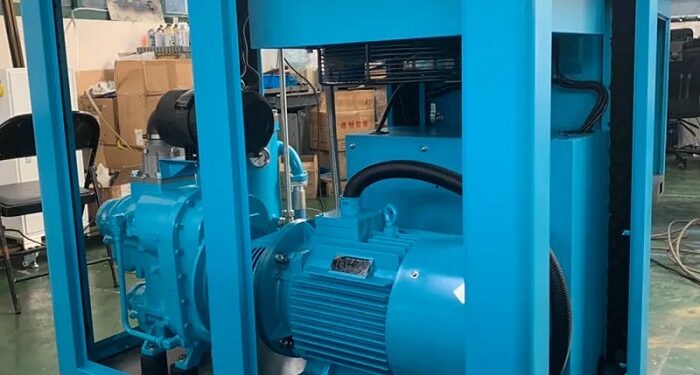An air compressor is a device designed to compress air to increase its pressure for subsequent use in various industrial and domestic applications. Its basic operating principle is based on mechanical compression of air, which generates energy for various tasks, such as pneumatic tools, automation systems, and other technical devices.
Among the types of air compressors, screw compressors occupy a special place, characterized by high efficiency and reliability. They use screw-shaped rotors to compress air through mutual rotation, ensuring stable operation and uniform compression without sudden pressure drops. Their operating principle is based on the sequential compression of air within special chambers, making them a popular choice in industry.
What is an air compressor and its functional features?
The main functional feature of an air compressor is the conversion of mechanical energy into compressed air. This is achieved through the operation of piston, screw or centrifugal mechanisms, which reduce the volume of air and increase its pressure. Depending on the compressor type, it may have different design features, but in general, its purpose is to ensure a stable and safe supply of compressed air to the system.
Key Components and Operating Principles of an Air Compressor
An air compressor consists of several main parts:
- Motor – drives the compression mechanism;
- Cyclone or piston mechanism – performs the actual air compression function;
- Receiver – a storage tank for compressed air;
- Ventilation and Regulation Systems – maintain the required pressure and prevent boiling over.
An air compressor operates by sequentially saturating the air with mechanical movements, which allows the desired pressure to be achieved. For example, in piston compressors, air is drawn into the cylinder, compression occurs due to the piston’s movement, and the compressed air is then transferred to the receiver or used directly. In screw compressors, compression occurs through the rotation of screw rotors, which ensures smoother operation and lower noise levels.
Operating Principle of Piston and Screw Compressors: Technical Aspects
Screw compressors are devices with two helical rotors that rotate within a housing with a gap between them. As the rotors rotate, air enters the interrotor space and, as the rotors rotate, is compressed between the helical rotors. This ensures smooth and continuous air compression, significantly increasing efficiency and reducing vibration compared to piston models. Screw compressors are more reliable and require less maintenance, and they can operate continuously for extended periods, making them a popular choice for industrial applications.
Technical Aspects of Operation
A piston compressor uses a cyclic process that includes air intake, compression by the piston, and exhaust. An important aspect is the effectiveness of the seals, which ensure minimal gas leakage. Furthermore, maintaining precise cylinder and piston dimensions ensures stable operation and high compressed air quality.
A screw compressor operates by rotating two rotary screws, which create a closed, sealed chamber for air compression. An important technical aspect is the precision manufacturing and balancing of the rotors, which ensures minimal losses and vibration. The system includes oil and cooling systems that maintain optimal temperatures and reduce component wear. This compressor provides continuous operation and greater productivity compared to piston-based compressors.
Key Components of the Unit: From the Engine to Air Receivers
At the heart of an air compressor is a complex set of key components, each of which plays a vital role in ensuring the efficient operation of the unit. Proper functioning of these elements ensures stable compressed air production and safe operation.
Let’s look at the main components of a compressor and their functions to understand how they interact to achieve optimal performance.
Main Components of an Air Compressor
- Engine – provides the drive for the air compression mechanism. It can be an electric motor or an internal combustion engine.
- Handles and Cranks – convert the engine’s rotary motion into reciprocating motion, necessary for the operation of piston systems.
- Piston and cylinder – create volumetric air compression due to the movement of the piston within the cylinder.
- Valve system – regulates the inlet and outlet of air, ensuring the correct compression and release cycle.
- Air receiver – accumulates and stabilizes compressed air pressure, reduces pulsation and increases system efficiency.
- Pressure regulator – allows you to set the desired pressure level in the system and protects equipment from overvoltage.
- Filters and dryers – purify the air from dust, moisture, and other contaminants, extending the life of system components.
In summary, the key components of an air compressor work closely together to ensure reliable and efficient operation. Their proper design and timely maintenance allow for the maintenance of stable air pressure, which is the key to successful operation in various industrial and household sectors.





















